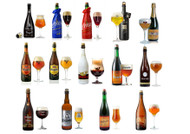Belgium, the land of beer
Posted by Isabelle Bellet on 21st Jul 2020
Why is beer associated with Belgium?
Belgian beer is listed as a World Heritage property.
Nearly 1500 different beers are produced in the country using different fermentation methods: from Pils, Abbey beers, Seasons beers, Trappist beers, Old Flemish browns, to the most elaborate lambic and Gueuzes, Belgium has a wealth of styles and a rare creativity.
Beer is an integral part of Belgium's history.
It was the drink of the monks, who mastered its production and know-how, enabling them to drink beverages purified from the diseases that devastated Europe in past centuries. This activity also enabled them to keep their community alive over the centuries.
Some monasteries continue to produce their beers within their community, the famous Trappist beers such as Westmalle, Rochefort or Chimay.
As early as the Middle Ages, many farms produced beer in winter, to quench the thirst of all their farm workers in summer. This beer is the origin of the Seasons beers. These farms continued to brew and thus became real brewing institutions, such as the Dupont brewery founded in 1759, the Dubuisson brewery founded in 1769 and the Du Bocq brewery founded in 1858.
Many historic breweries continue to brew according to the same traditional recipes, transmitted from generation to generation, sometimes for 5 generations.
In addition to these secular breweries, there are new brewers who work every day on new recipes and try something new.
Beer is much more than a festive consumer product in Belgium. It is certainly drunk in the evening or as an aperitif, but also increasingly at the table: Belgian (and French) restaurateurs are practising food-pairing (the pairing of beer and food). Each dish has its own beer or beers.
In short, beer is consumed in Belgium as nowhere else in the world.
A Belgian drinks 74 litres of beer a year, or one glass a day.
Every Belgian beer has its own story that is told around a good dinner.
No wonder Belgium is considered the land of beer!

